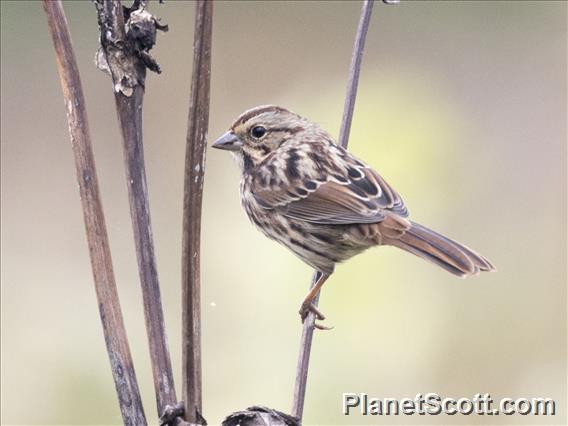Song Sparrow (Melospiza melodia)

Song Sparrow (Melospiza melodia)

Song Sparrow (Melospiza melodia)


×



Song Sparrow (Melospiza melodia)

Song Sparrow (Melospiza melodia)
About Song Sparrow (Melospiza melodia)
- Kingdom: Animals
- Phylum: Chordates
- Class: Birds
- Order: Perching Birds
- Family: Old World Buntings
The song sparrow is a medium-sized New World sparrow. Among the native sparrows in North America, it is easily one of the most abundant, variable, and adaptable species.
Source: Wikipedia
Trips
Visits
-
2006-02-16
Lake Merced , United States of America -
2007-01-01
Golden Gate Park - Lily Pond, United States of America -
2007-04-10
Ejido Lagoon, United States of America -
-
2008-08-26
Elgin - Bluff Spring Fen, United States of America -
2009-05-08
Burnidge Forest Preserve, United States of America -
2009-11-22
Palo Alto Baylands, United States of America -
2009-12-31
Palo Alto Baylands, United States of America -
2010-01-03
Sacramento National Wildlife Refuge, United States of America -
2010-02-16
El Rosario, Mexico -
2010-02-21
Lerma Marshes, Mexico -
2010-04-18
Point Reyes National Seashore, United States of America -
2010-05-27
Kenai Peninsula, United States of America -
2010-10-30
Miller Meadow Forest Preserve, United States of America -
2010-11-20
Elgin - Bluff Spring Fen, United States of America -
-
2012-06-13
Mount Davidson, United States of America -
2012-07-08
Necedah NWR, United States of America -
2012-07-09
Sax-Zim Bog, United States of America -
2012-07-10
Bluestem Prairie, United States of America -
2012-07-10
Arrowwood NWR, United States of America -
2012-09-15
Glen Canyon Park, United States of America -
2012-09-19
Golden Gate Park - North Lake, United States of America -
2012-09-22
East Wash, United States of America -
2012-09-30
Golden Gate Park - Stow Lake, United States of America -
2012-12-16
Lake Merced , United States of America -
2013-03-04
John Heinz NWR at Tinicum (IBA), United States of America -
2013-03-17
Lake Merced , United States of America -
2013-04-19
Bolivar Peninsula, United States of America -
2013-04-19
Anahuac NWR (UTC 049), United States of America -
2013-05-06
Mount Davidson, United States of America -
2013-09-01
Glen Canyon Park, United States of America -
2013-09-28
Presidio - El Polin Spring, United States of America -
2013-10-05
Corona Heights, United States of America -
-
2013-11-29
Lake Merced , United States of America -
2013-12-07
Golden Gate Park - San Francisco Botanical Garden, United States of America -
2014-01-04
Golden Gate Park - San Francisco Botanical Garden, United States of America -
2014-02-15
Lake Merced , United States of America -
2014-02-16
Golden Gate Park - San Francisco Botanical Garden, United States of America -
2014-02-22
Santa Fe Grade, United States of America -
2014-03-09
Los Angeles County Arboretum and Botanic Garden, United States of America -
2014-03-22
Baker Beach, United States of America -
-
2014-04-26
Bernal Hill, United States of America -
2014-05-03
Glen Canyon Park, United States of America -
2014-05-09
Cave Creek Canyon--Southwestern Research Station, United States of America -
2014-05-11
San Pedro RNCA--San Pedro House, United States of America -
2014-06-14
Peaarson-Arastradero Preserve, United States of America -
2014-06-15
Golden Gate Park - North Lake, United States of America -
2014-06-22
Redwood Valley, United States of America -
2014-08-23
MacKerricher SP, United States of America -
2014-09-20
East Wash, United States of America -
2014-09-23
Redwood Valley, United States of America -
2014-09-27
Mount Davidson, United States of America -
2014-10-02
Golden Gate Park - San Francisco Botanical Garden, United States of America -
2014-11-29
Lafayette Park, United States of America -
2014-12-08
Golden Gate Park - San Francisco Botanical Garden, United States of America -
2014-12-21
Arrowhead Marsh, United States of America -
2014-12-28
Glen Canyon Park, United States of America -
2015-01-19
Lake Merced , United States of America -
2015-01-20
Arrowhead Marsh, United States of America -
-
-
-
-
-
-
-
-
-
-
-
-
-
-
-
-
-
-
-
-
-
-
-
-
-
-
-
-
-
-
-
-
-
-
-
-
-
-
-
-
-
-
-
-
-
-
-
-
-
-
-
-
-
-
-
-
-
-
-
-
-
-
-
-
-
-
-
-
-
-
-
-
-
-
-
-
-
-
-
-
-
-
-
-
-
-
-
-
2023-10-10
Ferson Creek Fen, United States of America -
-
-
-
-
-
-
-
-





